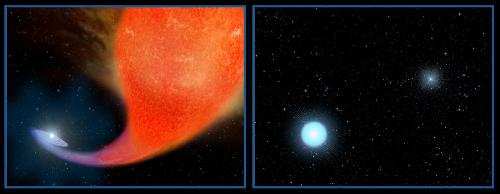MADISON, Wis. -- Starting around 1950, a series of advances formed a clear and accepted picture of how individual stars are born, evolve and die. As they age, the changing patterns of color, light output, size and lifespan of stars are predictable. Every star like the sun will become a red giant, a planetary nebula and finally a white dwarf.
But half of all stars are in binaries -- pairs of stars that orbit each other. Half of binary stars orbit so close that gravitational interaction significantly affects their evolution and demise. Today, scientists led by Robert Mathieu, a professor of astronomy at the University of Wisconsin-Madison, and his former student Natalie Gosnell confirmed one of the possible explanations for a common group of exceptions: the blue stragglers.
Blue stragglers look younger and brighter than their age would suggest -- skirting, in other words, the clean, clear rules of stellar evolution. Since their discovery in 1953, blue stragglers have been begging for explanation. Had two stars collided to form a more massive star? Was a blue straggler "stealing" gas from a companion star?

In recent years, based on observations at the WIYN telescope at Kitt Peak, Arizona, Mathieu and his students have established that over three-quarters of blue stragglers, in fact, have stellar companions.
This week, in a paper in The Astrophysical Journal, Gosnell, Mathieu and colleagues identified the orbital partner that was parasitized by the blue straggler. The victim, they found, was a red giant that donated hydrogen gas for eons until it was eventually transformed into a white dwarf -- the old, small, bright and dense remnant of a red giant.
The researchers used the Hubble Space Telescope to study the "colors" of far ultraviolet light coming from blue stragglers and their companions. At a distance of 5,500 light years, the blue straggler binary appears as a single point of light, but by analyzing the amount of ultraviolet light, the researchers saw the unmistakable signal of a white dwarf.
The study builds on a series of logical deductions. The stars being studied were identified as members of a binary pair because they periodically move closer to and further from Earth -- the hallmark of an orbiting pair of stars. Their optical color and intensity marked them as blue stragglers. They are bright in the far ultraviolet, a trademark of a hot white dwarf. And finally, for the white dwarfs to still be hot and detectable, they can only be 300 million years old. "These blue stragglers were formed 'yesterday,'" says Mathieu.
White dwarfs form when certain stars lose their outer atmospheres. The mass "must be going somewhere," Gosnell says, "and that's to the companion normal star, which is close enough to attract the mass through gravity. Therefore, the white dwarf is left over after adding mass to a star, which becomes the blue straggler."
The study expands our understanding of a major area of stellar evolution. If half of all stars are in binaries, and half of the binaries are, like the blue straggler, close enough to have gravitational interaction, then "these stars are not just an afterthought, a contaminant to our neat picture," Gosnell says. "We need to bring this 25 percent of all stars into the fold, so we can say we really understand how stars evolve."
If scientists don't know how the blue stragglers formed, they are in a poor position to understand how they will evolve and die, adds Gosnell, who is now a postdoctoral fellow at the University of Texas. "Of course, we still have a third of the blue stragglers to figure out. I think we also have some stellar collisions in there."
"Our understanding of single-star evolution is one of the great intellectual achievements of the last century," says Mathieu. "We began with points of light in the sky, and with the application of new instrumentation, the physics breakthroughs of the last century, and computers, we took those points of light and turned them into a narrative of star life.
"For the evolution of single stars like our sun, by and large, we got it right, from birth to death. Now we're starting to do the same thing for the one-quarter of stars that are close-orbiting binaries. This work allows us to talk not about points of light, but about the evolution of galaxies, including our own Milky Way. That's a big deal, and getting it right is an even bigger deal."





Comments